The Role of Shiv Puran in Spirituality
The Role of Shiv Puran in Spirituality
Delve into the mystical world of Hindu mythology with complete knowledge of Shiva Purana. Discover the deep significance of Lord Shiva and his divine teachings.
Hindu mythology is filled with fascinating stories of gods and goddesses, each with its own unique powers and personalities. Lord Shiva, one of the most prominent deities in Hinduism, is revered as the destroyer of evil and the embodiment of pure consciousness. The Shiva Purana, a sacred text describing the life and teachings of Lord Shiva, is a testimony to the Lord's benevolence and spiritual wisdom.
History and Origin of Shiva Purana
The Shivpurana has been passed down through generations as oral traditions and later as written texts. The earliest written version of the Shivpurana is believed to have been composed between the 3rd and 10th centuries AD. The text was later expanded and revised by various scholars over the centuries, resulting in the current version of the Shiva Purana.
Structure of Shiva Purana:
The Shiva Purana is a huge text with over 24,000 verses. It is divided into seven Samhitas or sections, each covering a different aspect of the life and teachings of Lord Shiva. The sections are:
- Vidyashvara Samhita
- Rudra Samhita
- Shatrudra Samhita
- Koti Rudra Samhita
- Uma Samhita
- Kailash Samhita
- Dharma Samhita
Each section of the Shiva Purana has a specific focus and contains stories and teachings related to Lord Shiva. Some of the major stories from the Shiva Purana include the creation of the universe, the story of the churning of the ocean, the marriage of Lord Shiva and Goddess Parvati, and the battle between Lord Shiva and the demon Jalandhara.
Vidyashvara Samhita: This section is the introductory section of the Shiva Purana and provides an introduction to the text. It also includes hymns and prayers dedicated to Lord Shiva.Rudra Samhita: This section is the longest and most important section of the Shiva Purana. It is further divided into five parts, which are as follows:
- Srishti Khanda: This section deals with the creation of the universe and the evolution of life forms.
- Sati Khanda: This section tells the story of Sati, the first wife of Lord Shiva, and her tragic death.
- Parvati Khand: This section tells the story of Lord Shiva's second wife Parvati and their marriage.
- Kumar Khanda: This section tells the story of Lord Kartikeya, also known as Lord Murugan or Skanda, the son of Lord Shiva.
- Yodda Khanda: This section tells the story of the battles fought by Lord Shiva and his followers against demons and evil forces.
Uma Samhita: This section is dedicated to the goddess Uma, an aspect of the divine feminine who is worshiped as Parvati or Durga.
Vayavya Samhita: This section contains hymns and prayers dedicated to Lord Shiva in the form of Vayu or the air god.
Dharma Samhita: This section deals with the principles of dharma or righteous conduct, and includes teachings and guidelines for leading a virtuous life.
Significance of Shiv Purana
The Shiva Purana is an important text in Hindu mythology that provides valuable insights into the nature of the universe and the role of Lord Shiva in it. It is a guidebook for living a spiritual life and teaches valuable lessons about devotion, faith, meditation, karma, and righteousness. By understanding the significance of the Shiva Purana, one can deeply appreciate the rich cultural and religious traditions of Hinduism. The Shiva Purana is considered one of the most important texts in Hindu mythology. It is a guidebook for living a spiritual life and provides insight into the nature of the universe and the role of Lord Shiva in it. Some of the key lessons to be learned from the Shiva Purana include:
- Importance of devotion and faith in Lord Shiva
- There is a need to give up material desires and focus on spiritual development
- The power of meditation and its ability to connect us with the divine
- Importance of Karma and its effect on our life
- Concept of Dharma or righteousness and its role in leading a meaningful life.
Shivpuran also offers a glimpse of the rich cultural and religious traditions of Hinduism. It is a source of inspiration for millions of people around the world who seek spiritual guidance and wisdom. The Shiva Purana is a Hindu religious text containing several mythological stories related to Lord Shiva, one of the most revered deities in Hinduism. These stories provide insight into the character of Lord Shiva, his relationships with other gods and beings, and his importance in Hindu mythology.
Attributes and Symbolism of Lord Shiva as per Shiva Purana
Lord Shiva is one of the three main deities in Hinduism and is known for his many attributes and symbolic representations. Here are some of the key features and symbols associated with Lord Shiva:
Third Eye: Lord Shiva is often depicted with a third eye on his forehead, which represents his spiritual insight and wisdom. The third eye is also said to be the source of his destructive power, which he can unleash upon those who deserve punishment.
Trishul: The Trishul, or Trishul, is a symbol of the power and authority of Lord Shiva. It represents the three aspects of creation, preservation, and destruction, and is often depicted in his hand.
Snake: Lord Shiva is often depicted wearing a snake around his neck, symbolizing his power over death and the cycle of birth and rebirth.
Damru: Damru is a small drum that is often depicted holding Lord Shiva. It represents the rhythm of the universe and the cosmic sound that is said to have brought the universe into existence.
Linga: Linga is a sexual symbol that represents the creative energy and the power of regeneration of Lord Shiva. Linga worship is an important part of Shaivism, the branch of Hinduism that worships Lord Shiva as the supreme deity.
Bhasma: Lord Shiva is often depicted covered in ashes, representing his detachment from material possessions and focus on spiritual enlightenment.
Blue Throat: Lord Shiva is sometimes referred to as Neelkanth, which means "blue throat." According to legend, Lord Shiva drank poison to save the universe from destruction, which turned his throat blue.
Most popular mythical tales of Shiv Puran Katha
Creation of the Universe:
The creation of the universe is an important section of the Shiv Puran Katha, one of the most revered Hindu religious texts. The story tells how Lord Shiva, the supreme deity of Hinduism, created the universe, along with the gods and goddesses who live in it.
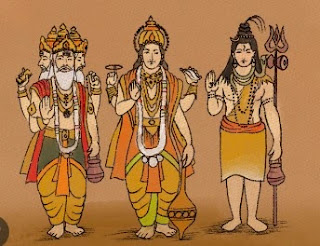 |
| Brahma, Vishnu, and Mahesh |
According to the story, Lord Shiva existed in a state of formless, infinite consciousness before the creation of the universe. He then entered a state of deep meditation and began to contemplate the nature of creation. When he meditated, a spark of divine light emanated from his third eye and this light spread rapidly, giving rise to the universe. As the universe took shape, Lord Shiva created the three main deities who preside over it: Brahma, Vishnu, and Mahesh (or Shiva himself). Brahma is the creator of the universe, Vishnu is the maintainer, and Mahesh is the destroyer. Lord Shiva also created many other gods and goddesses, each with their own unique characteristics and powers. The story emphasizes the cyclical nature of the universe, with creation, preservation, and destruction occurring in a constant cycle. It also emphasizes the importance of balance and harmony, as Lord Shiva created the universe in such a way that balance and order prevail.
Samudra Manthan Katha:
This Shiv Puran Katha tells how the gods and demons churned the ocean together to obtain the elixir of immortality. The story begins with the gods and demons seeking to obtain the elixir of immortality in order to become immortal and have eternal life. Lord Vishnu, one of the principal deities of Hinduism, suggested that they work together to churn the ocean to bring the nectar to the surface.
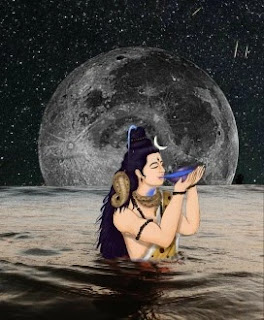 |
| Shiv Drinking Halahala |
Marriage of Lord Shiva and Parvati:
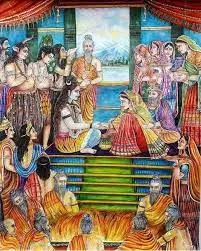 |
| Shiv Parvati Marriage |
The Shiva Purana contains many stories related to Lord Shiva's relationship with Parvati, his wife. The story of their marriage is particularly popular, as it highlights the union of the divine masculine and feminine energies and the importance of a balanced and harmonious relationship.
Birth of Lord Ganesha:
According to legend, Goddess Parvati, the wife of Lord Shiva, longed for a child. She decided to create a child using the sacred ashes from her body. He created a human-like figure from the ashes and breathed life into it, from which a boy was born whom he named Ganesha.
 |
| Birth of Lord Ganesha |
Ganesha was a unique child with the head of an elephant and a human body. He was also very intelligent and had great knowledge and understanding of the world. He became the beloved son of Lord Shiva and Goddess Parvati. One day, when Ganesha was guarding his mother's chamber, Lord Shiva returned home from his meditation and tried to enter the chamber. Not recognizing Lord Shiva as his father, Ganesha stopped him. There was a heated argument between the two and in a fit of rage, Lord Shiva beheaded Ganesha. When Goddess Parvati came to know what had happened to her beloved son, she was filled with grief and anger. She demanded that Lord Shiva bring her son back to life. Lord Shiva promised to do so and sent his attendants to find a new head for Ganesha. The attendants were only able to find the head of an elephant, and Lord Shiva used it to revive Ganesha. From that day, Ganesha was known as the god of wisdom and knowledge and became a beloved deity in Hinduism. The story of Lord Ganesha's birth emphasizes the importance of family and the power of love and devotion. It also highlights the wisdom and knowledge of Lord Ganesha, who is revered as the remover of obstacles and the god of new beginnings.
This story continues to inspire and guide Hindus all over the world and has played a significant role in shaping Hindu culture and spirituality.
Annihilation of Tripura:
Annihilation of Tripura is a popular story in Hindu mythology, described in the Shiva Purana, a revered Hindu religious text. The story tells how Lord Shiva destroyed three cities made of gold, silver, and iron, which came to be known as Tripura.
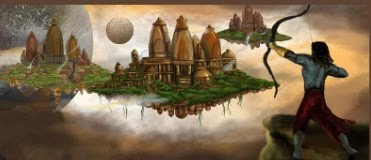 |
| Shiva destroyed three cities |
According to legend, three demon brothers, Tarakaksha, Vidyunmali, and Kamalaksha, built three invincible cities made of gold, silver, and iron. They lived in these cities and troubled the gods and sages, creating chaos and mayhem wherever they went. The deities approached Lord Brahma, the creator of the universe, for help. Lord Brahma suggested that they seek the help of Lord Shiva, the destroyer of evil. Lord Shiva agreed to help and prepared for battle. Lord Shiva mounted his bull, Nandi, and carried his Trishul, which symbolizes his power. He approached the three cities, which were in perfect alignment, and shot an arrow that passed through all three cities at once, destroying them completely. The demon brothers tried to run away, but Lord Shiva chased them and destroyed them with his trident. The destruction of Tripura brought peace and order back to the universe, and the gods and sages were able to resume their normal lives. The story of the destruction of Tripura emphasizes the importance of standing up against evil and the power of righteousness. It also highlights the role of Lord Shiva as the protector and destroyer of evil. This story continues to inspire and guide Hindus all over the world and has played a significant role in shaping Hindu culture and spirituality.
The legends of the Shiv Puran Katha offer a fascinating glimpse into the world of Hindu mythology and the character and significance of Lord Shiva. They continue to inspire and fascinate Hindus all over the world and have played a significant role in shaping Hindu culture and spirituality.
Teachings of Lord Shiva in Shiva Purana
The Shiva Purana is a Hindu religious text containing a wealth of teachings and guidance given to Lord Shiva, one of the most revered deities in Hinduism. Some of the major teachings of Lord Shiva mentioned in the Shiva Purana are as follows:
Importance of Bhakti: Lord Shiva emphasizes the importance of devotion to God and encourages his followers to lead a life of faith and devotion. He insists that the ultimate goal of life is to attain liberation and merge with the divine, and devotion is the key to achieving this goal.
Renunciation: Lord Shiva is often depicted as a renunciate, and his teachings emphasize the importance of detachment from material possessions and worldly desires. He teaches that true happiness and fulfillment can only be achieved through spiritual growth and self-realization, and not through material wealth or status.
Karma: Lord Shiva emphasizes the importance of Karma or the law of cause and effect. He teaches that every action has a consequence and that one should always strive to do good and avoid harming others. He also emphasizes that one's intentions are as important as one's actions.
Unity: Lord Shiva teaches that all beings are ultimately one and that clear division between individuals is illusory. He exhorts his followers to see the divine in all beings and to treat others with kindness and compassion.
Self-realization: Lord Shiva teaches that the ultimate goal of life is self-realization or realizing one's true nature as the divine. He encourages his followers to engage in spiritual practices such as meditation and self-inquiry to achieve this goal.
In the Shiva Purana, Lord Shiva emphasizes the importance of spiritual growth, devotion, and self-realization. He exhorts people to lead a life of righteousness, compassion, and disinterestedness and to see the divine in all beings. These teachings continue to inspire and guide Hindus all over the world.
What is the Powerful Mantra in Shiv Puran?
The Shiva Purana (Mahapurana) is a revered Hindu religious text that contains many mantras and hymns dedicated to Lord Shiva, one of the three principal deities of Hinduism. One of the most important mantras in the Shiva Purana is the Maha Mrityunjaya Mantra, also known as the Tryambakam Mantra.
The Maha Mrityunjaya Mantra is a powerful hymn that is believed to provide protection and healing to devotees who recite it with devotion and sincerity. The mantra is composed of several Sanskrit verses and is dedicated to the god Shiva, who is often associated with the power of destruction and renewal.
The mantra is as follows:
Sugandhim Pushti-vardhanam
Urvarukamiva Bandhanan
Mrityor Mukshiya Maamritat
"We worship the one with three eyes (Lord Shiva)
Who is fragrant and nourishes all beings;
Deliver us from death and grant us immortality."
The Maha Mrityunjaya Mantra is considered the supreme mantra in the Shiv Puran Katha and is often chanted during important rituals and ceremonies. It is believed to have the power to heal physical and emotional ailments, remove obstacles and negativity, and provide spiritual protection to the devotees. The Maha Mrityunjaya Mantra is a testament to the power and benevolence of Lord Shiva and continues to inspire and guide Hindus all over the world. Its importance and power have made it one of the most widely recognized and revered mantras in Hinduism.
Relevance of Shiva Purana in modern times
The Shiva Purana contains stories, hymns, and chants dedicated to Lord Shiva, one of the three principal deities of Hinduism. Although the text is thousands of years old, its teachings and relevance continue to inspire and guide Hindus around the world, even in modern times.
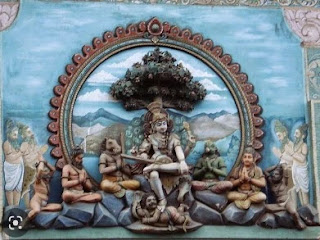 |
| Shiva Purana |
Guidance to lead a virtuous life: The Shiva Purana provides a wealth of wisdom and guidance to lead a virtuous life. The text teaches the importance of self-discipline, compassion, and devotion to God. These teachings are as relevant today as they were thousands of years ago.
Understanding the Nature of the Universe: The Shiva Purana provides insight into the nature of the universe and the cycle of birth, death, and rebirth. This knowledge can help us understand the purpose of our existence and the role we play in the larger scheme of things.
Source of Spiritual Inspiration: The Shiva Purana is a rich source of spiritual inspiration that can help us connect with our inner self and with God. The hymns and mantras in the text can be used for meditation and contemplation, helping us to gain a deeper understanding of our spiritual nature.
Promotes unity and tolerance: The Shiva Purana, like other Hindu scriptures, promotes unity and tolerance among people of different religions and backgrounds. The text teaches that all living beings are connected and that we should treat each other with love and respect.
Promotes environmental consciousness: The Shiva Purana contains stories and teachings that emphasize the importance of environmental consciousness and the need to protect nature. These teachings are especially relevant today, as the world faces environmental challenges such as climate change and deforestation.
FAQs:
Q: Who is Lord Shiva?
A: Lord Shiva is one of the three major deities in Hinduism, along with Lord Brahma and Lord Vishnu. He is known as the destroyer of evil and the god of ascetics and meditation.
Q: What is the Shiv Puran?
A: The Shiv Puran is a sacred text that chronicles the life and teachings of Lord Shiva, one of the most prominent deities in Hinduism.
Q:Who wrote Shiv Puran (Shiv Mahapuran)?
A: Shiv Puran was originally written in Sanskrit by Romaharshana who was a disciple of Sage Maharishi Ved Vyasa.
Q: What are the major sections of the Shiv Puran?
A: The Shiv Puran comprises six major sections or Samhitas, namely, the Vidyesvara Samhita, Rudra Samhita, Shata Rudra Samhita, Koti Rudra Samhita, Uma Samhita, and Kailasa Samhita.
Q: What is the significance of Lord Shiva in Hinduism?
A: Lord Shiva is revered as a powerful and benevolent deity who represents the principles of destruction and regeneration. He is also considered the lord of dance, music, and arts.
Q: What are some of the teachings of Lord Shiva in Shiv Puran?
A: Lord Shiva's teachings in Shiv Puran emphasize the importance of devotion, meditation, karma, and dharma. He also stresses the importance of balancing one's material and spiritual pursuits.
Q: What are some of the mythical tales in Shiv Puran?
A: Shiv Puran contains many fascinating tales, such as the story of Lord Shiva's marriage to Parvati, the story of the churning of the ocean, and the story of the birth of Lord Ganesha.
Q: How is Shiv Puran relevant to modern times?
A: Shiv Puran continues to hold immense spiritual significance in Hinduism, and its teachings are still relevant today. It can serve as a guide for seekers of spiritual enlightenment and help individuals find balance in their lives.
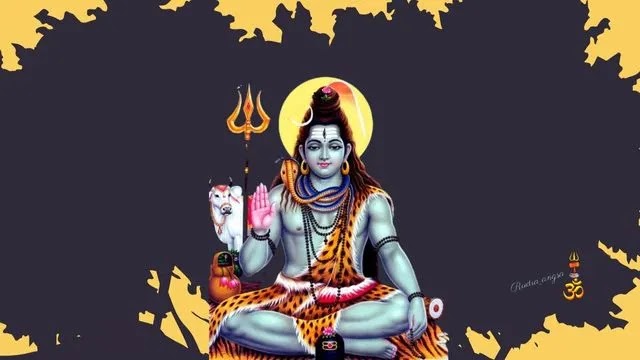


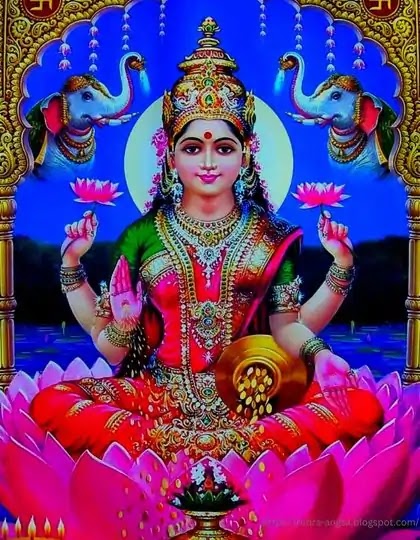


.webp)
